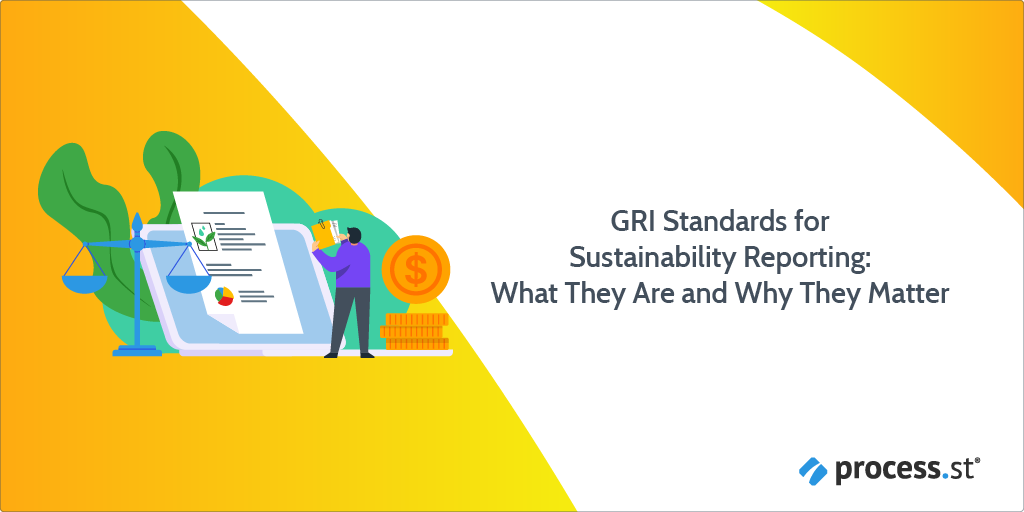
You’re cooking for corporate success, but how do you know when it’s time to add a little sustainability into the mix?
Sustainability is the key ingredient, like the spice in your curry, or the sugar in your cake, that brings long-term economic prosperity.
So before you fire up on all cylinders, consider this: companies that adopted environmental, social and governance policies in the 1990s have long since outperformed those that didn’t today.
If you have read some of Process Street‘s previous articles, such as How You Can Create a Sustainable Business for Long-Term Business Succes, you will learn that there is a strong, unbreakable tie between our environment, society, and the economy. It is with this undeniable relationship, that GRI Standards reporting came about.
GRI Standards will help you produce a sustainability report, and by doing so, you are taking a huge leap towards securing business sustainability and cooking up long-term corporate success.
In this article, I will explain why GRI Standards reporting is important, what GRI Standards are, and how you can implement GRI Standards for the production of your sustainability report today. You are provided with free and ready to use templates for implementation of the three universal GRI Standards reports.
- GRI Standards 101: Foundation 2016 Checklist Template
- GRI Standards 102: General Disclosures 2016 Checklist Template
- GRI Standards 103: Management Approach 2016 Checklist Template
Ready to become a GRI Standards expert and start implementing GRI Standards into your business today?
Let’s read on!
Why GRI Standards reporting is needed

I want you to take a look at the image above.
Controversial statement, right? But what has this got to do with GRI reporting?
We’ll get to that, but first I want you to consider the image above as an example of a false advertisement. It is only with today’s knowledge in regards to the consequential impacts of smoking, that right now, you’re probably sitting with a huge gap between your top and bottom molars.
What an outrageous claim Viceroy cigarettes made!
Now consider the image below.
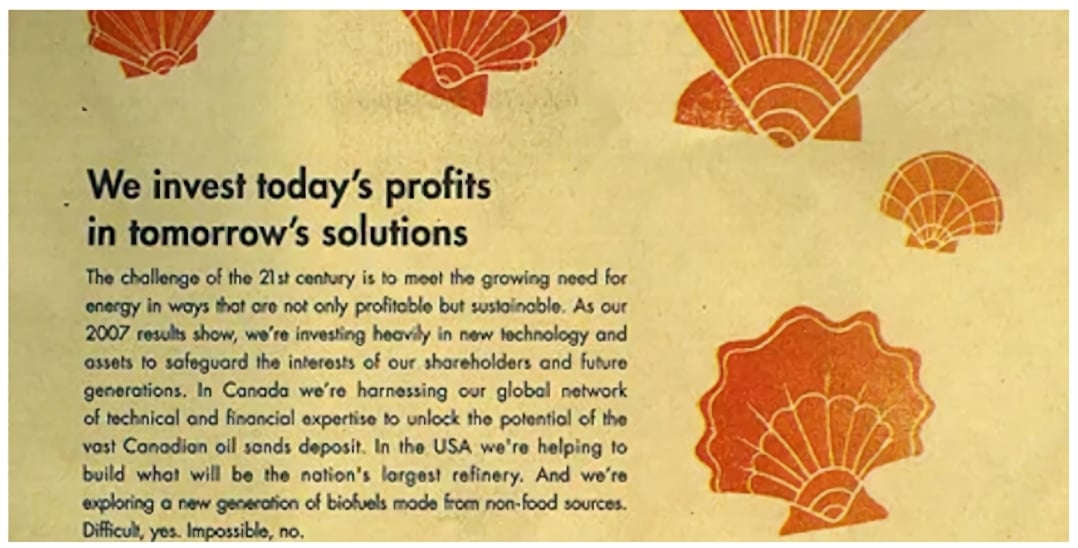
Does this seem controversial to you?
The controversy doesn’t glow so blatantly as it does in the Viceroy campaign, but peel away the green patina and you puncture the advertisement’s claim to sustainability. A claim that is full of hot air and has little substance. This is an example of greenwashing.
Greenwashing is the practice of making an unsubstantiated or misleading claim about the environmental benefits of a product, service, technology or company practice. Greenwashing can make a company appear to be more environmentally friendly than it really is. – TechTarget, greenwashing
It is with this specific form of false advertisement – greenwashing – where GRI Standards come in.
I used the Vicerory campaign to emphasize just how damaging false advertisements can be. We all know that smoking will never be prescribed by your dentist, and is damaging to your teeth and health.
False advertisement via greenwashing can be just as detrimental.
‘We invest today’s profits in tomorrow’s solutions’ was a campaign produced by the oil company Shell, in an attempt to gain support for Shell’s Oil Sands Project.

The Oil Sands project targets Northern Canada’s tar sands that stretch over 140,000 square kilometres of Alberta. The sands are strip-mined from vast open pits to obtain oil that ultimately releases eight times more emissions than conventional oil.
Is this really a solution for tomorrow?
Perhaps tomorrow we will look at such advertisements with the same shock and disbelief that we had viewing the Viceroy campaign.
The goal of GRI Standards is to create a specification that corporations can follow to report on the economic, environmental and social aspects of a business. With GRI Standards a company’s sustainability efforts can be correctly determined by all stakeholders, and not drowned under a company’s false claims of a green persona.
With this transparency of information, potentially damaging claims to sustainability can be recognized.
The Shell campaign was soon branded as greenwashing by the Advertising Standards Authority, an action possible with the level of business transparency we see today. This branding dirtied Shell’s image to the ever-increasing eco-conscious consumer, to such an extent that Shell soon followed other key players in quitting the sector of tar sand oil. Tar sand oil is the dirtiest source of oil and it is with global interest that cleaner alternatives should be focussed upon.
Wth the disclosure of information granted by standards such as the GRI Standards, key stakeholders can have a say in regards to a companies sustainability efforts. After all, we all live under the same sky, wouldn’t you want to know exactly what emissions are being released and not deceived with a false pretense of green business?
Morally speaking from a consumer point of view, we can clearly see the importance of GRI Standards. However, what can GRI reporting do for your business?
The benefits GRI Standards reporting brings to a business
GRI reporting is all about disclosure of information in a set, standard way, so that information in regards to a companies economic, environmental and social performance can be easily quantifiable and compared. Research has shown that by having a systematic approach to reporting, the following benefits can be reaped:
- Improved sustainability performance
- Improved risk management and investor communications
- Engagement with stakeholders and improved stakeholder relations
- Motivated and engaged employees
- Stronger credibility as a committed and effective corporate citizen
- Stronger internal data management and reporting systems
- Improved sustainability strategy and selection of performance indicators and targets
- A means to benchmark sustainability performance against self and others
So far, we understand that GRI reporting is a set of standards that you can follow to report on your business activities from an environmental, economic and social stance. But, how are GRI Standards produced? What is the history of GRI Standards? What exactly are GRI Standards?
GRI Standards: A broken-down overview
GRI Standards were produced to provide an international, standardized language that corporations could use to report on their business sustainability efforts. That is, to disclose information in regards to corporate impacts, both negative and positive, on environmental, social and economical features of the business.
All in all, GRI Standards help businesses produce a sustainability report so that corporate activities can be assessed and improved upon, to obtain a more sustainable business for long-term business success.
A GRI Standards draft was released in 1997, before the establishment of the first full version in 2000. Since updates and new releases of the Standards have been made, to provide the latest 2016 GRI Standards edition that is used today. These Standards were produced by the United States-based non-profit group Ceres (Coalitions for Environmentally Responsible Economies), a Boston Massachusetts based organization formed in 1989, and named as one of most 100 influential players in corporate governance.
With the aim to standardize the reporting of environmental, social and governance costs and benefits in business, GRI Standards operate worldwide, and their adoption for sustainability reporting is increasing. This is due to the fact that the link between the environment, our society, and the economy is becoming more and more understood.
In addition, since December 2014, the European Commission Directive adopted a new obligation that large multinational corporations should provide a non-financial disclosure to the markets. That is, it became law that public companies with more than 500 employees should provide a report detailing environmental and social facets of business, using recognized frameworks such as the GRI Standards.
GRI Standards allow third parties to assess a company’s activities and the impacts these activities have in regards to business sustainability. They are especially important for companies with more than 500 employees, as a result of these new laws and regulations.
GRI is an independent body, however, collaboration with the United Nations Environmental Protection Agency and the United Nations Global Compact aids the production and continual review and assessment of the Standards. The GRI Standards are created in accordance with international labor practices and environmental impacts, by conducting independent audits. For example, ISO 14000 series, which includes ISO 14010, IS0 14011, IS0 14012 and ISO 26000, set out guidelines for assessing environmental impact, while OHSAS 18001 lays down a health and safety risk management system. GRI Standards are produced in accordance with these, and other, series.
GRI Standards are structured in a set of interrelated modules, that can be referenced and used together. There are three core modules, known as GRI’s 100 series. This GRI 100 series are universal standards that apply to every organization preparing a sustainability report, and are as follows:
- GRI Standards 101: Foundation
- GRI Standards 102: General Disclosures
- GRI Standards 103: Management Approach
On referencing these universal GRI Standards, an organization can then look at the topic-specific GRI Standards, to report on what is known as material topics.
A material topic is a topic that reflects a reporting organization’s significant economic, environmental and social impacts; or that substantively influences the assessments and decisions of stakeholders – GRI 101: Foundation 2016, Key Terms
These topic-specific Standards are organized into three series: 200 (Economic topics), 300 (Environmental topics) and 400 (Social topics). The image below details how these topics are organized.
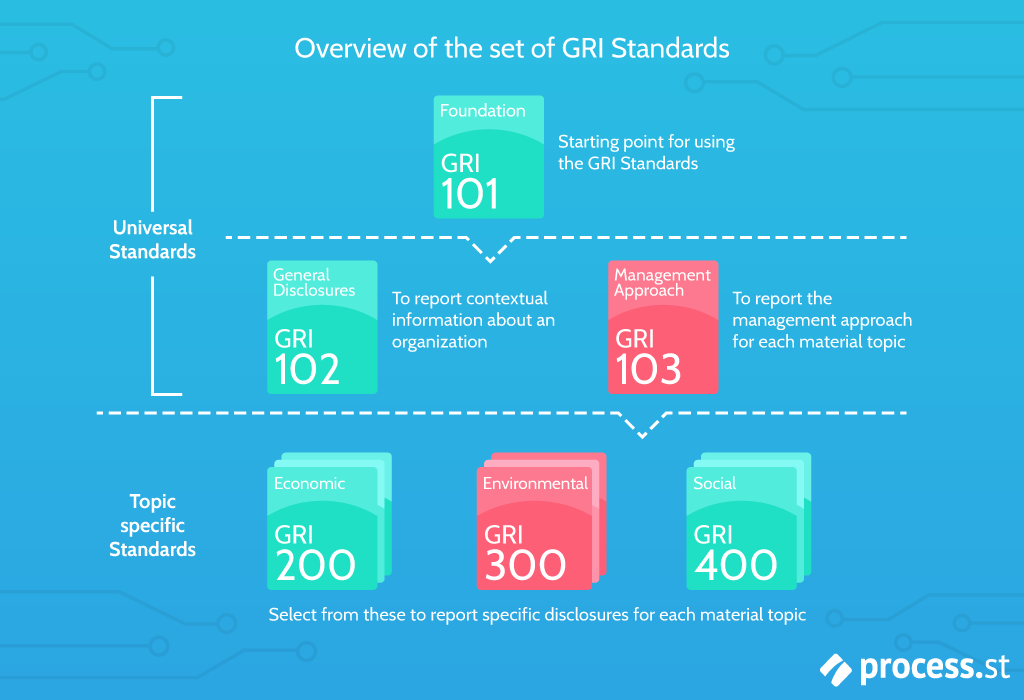
How you can use Process Street for your GRI reporting
Process Street is a top Business Process Management software, that provides superpowered checklists to allow you to efficiently and effectively manage your business processes.
In this case, we are talking about GRI reporting and the processes used to create a sustainability report that complies with GRI Standards.
We at Process Street recognize the fact that producing a sustainability report for your business may initially seem a bit, well…daunting.
Where do you start? What do you include? How do you make sure all key topics are reported on?
This is why Process Street has delved into the GRI Standards, sieving out key and vital information to produce a series of templates that are free and ready to use right away.
These templates run through the process of applying the GRI Standards to your sustainability report, making the process easy and actionable via utilizing features such as the below:
- Stop tasks ensure task order and make sure no priority task goes incomplete. This assures that all GRI Standards are applied as required
- Conditional logic ensures that the GRI Standards applied as required for your specific business and circumstance
- Variables which condense all information concisely to ease understanding and enable a quick overview of the GRI Standards applied
As mentioned at the start of this article, we give you the three universal GRI Standards as templates:
- GRI Standards 101: Foundation 2016 Checklist Template
- GRI Standards 102: General Disclosures 2016 Checklist Template
- GRI Standards 103: Management Approach 2016 Checklist Template
Scroll down for more information regarding these templates.
GRI Standards 101: Foundation 2016 Checklist Template
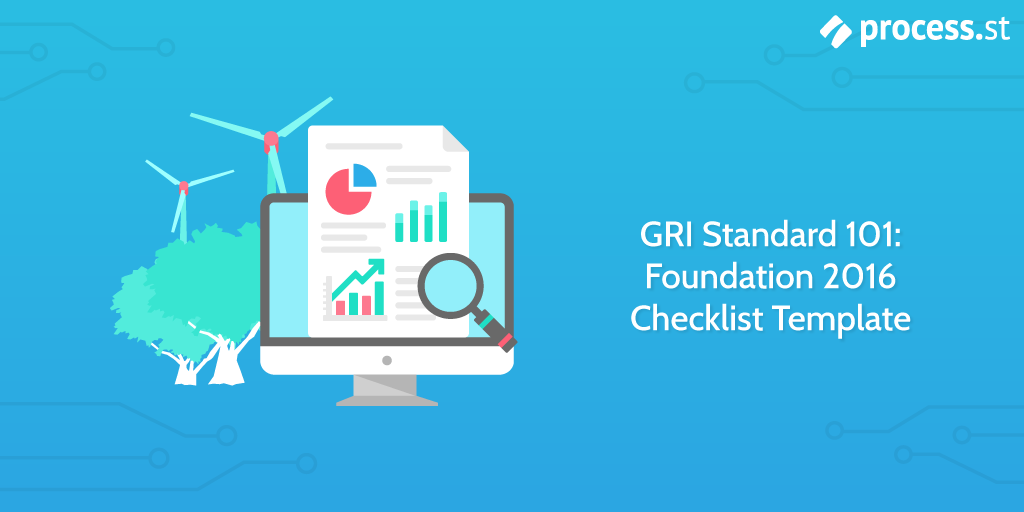
Process Street has created this GRI Standards 101: Foundation 2016 Checklist Template from the GRI Standards 101: Foundation 2016 report. The GRI 101: Foundation 2016 Standards provide a starting point for an organization to document its economic, environmental and social impacts. Reporting principles are set out to define sustainability reports’ content and quality.
Click here to access the GRI Standards 101: Foundation 2016 Checklist Template
GRI Standards 102: General Disclosure 2016 Checklist Template

Process Street has created this GRI Standards 102: General Disclosure 2016 Checklist Template from the GRI Standards 102: General Disclosure 2016 report. The GRI 102: General Disclosure 2016 Standards are used to report on contextual information about itself and the sustainability reporting practices.
Click here to access the GRI Standards 102: General Disclosure 2016 Checklist Template
GRI Standards 103: Management Approach 2016 Checklist Template
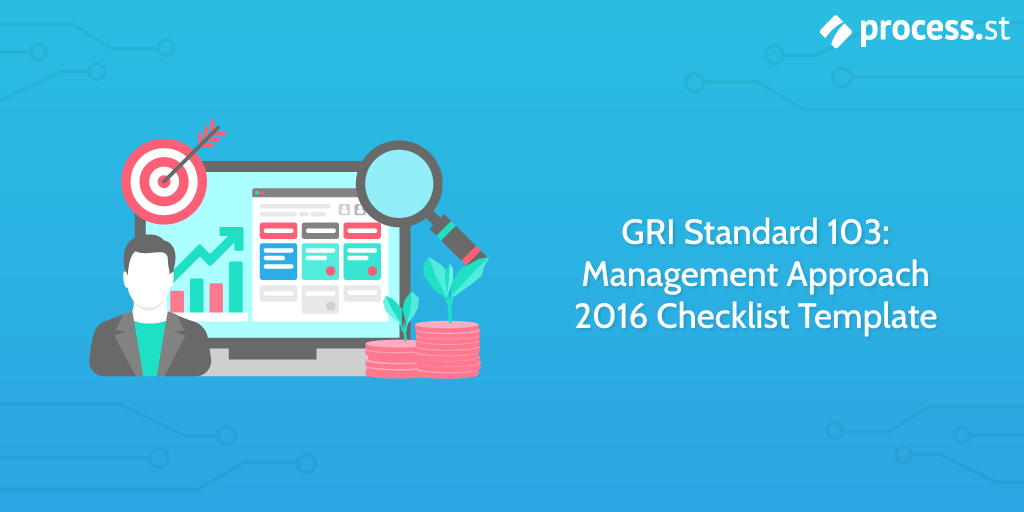
Process Street has created this GRI Standards 103: Management Approach 2016 Checklist Template from the GRI Standards 103: Management Approach 2016 report. The GRI 103: Management Approach 2016 Standards enable an organization to provide an explanation as to how they manage economic, environmental and social impacts. A narrative of information is provided on how the organization identifies, analyzes, and responds to its actual and potential impacts.
Click here to access the GRI Standards 103: Management Approach 2016 Checklist Template
Implement GRI Standards for the creation of your sustainability report
In this article, we have looked at what GRI Standards are and why they are important.
You are provided with three ready to use templates for actionable implementation of the three universal GRI Standards. These templates will help you get started in the creation of your sustainability report.
Keep an eye out for our upcoming content, that will delve into detail in regards to GRI’s topic-specific standards. That is the 200 (Economic topics), 300 (Environmental topics) and 400 (Social topics) GRI Standards series.
By creating a sustainability report that applies GRI Standards, you can easily assess your business operations from a sustainability perspective. With such an assessment, you can improve your operations to and adapt as a greener business. This will ultimately benefit your bottom line.
Why not check out some of our other resources and articles that can help you create a sustainable business, the links are provided below:
- ISO 14001 EMS Structure Template
- ISO 14001 EMS Mini-Manual Procedures
- ISO 14001 Environmental Management Self-Audit Checklist
- ISO 14001:2004 to ISO 14001:2015 EMS Transition Checklist
- ISO 9001 and ISO 14001 Integrated Management System (IMS) Checklist
- Environmental Accounting Internal Audit
- Hotel Sustainability Audit
- What is Environmental Management and How You Can Implement it Today?
- How You Can Create a Sustainable Business For Long-Term Business Success
We’d love to hear about the different ways you are sustainable in your business operations in the comments below. Please comment with any questions you have regarding business sustainability and GRI reporting. Who knows, you may even get featured in an upcoming article!







Jane Courtnell
Hi there, I am a Junior Content Writer at Process Street. I graduated in Biology, specializing in Environmental Science at Imperial College London. During my degree, I developed an enthusiasm for writing to communicate environmental issues. I continued my studies at Imperial College's Business School, and with this, my writing progressed looking at sustainability in a business sense. When I am not writing I enjoy being in the mountains, running and rock climbing. Follow me at @JaneCourtnell.